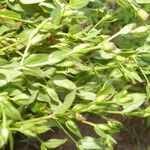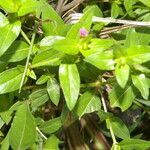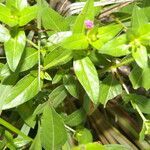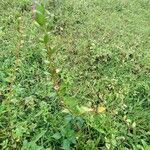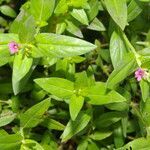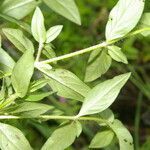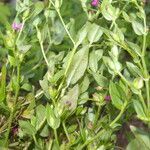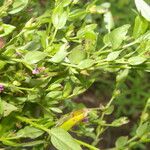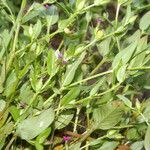Erect herbs to 4.5 dm. tall, sometimes subligneous near the base, simple to alternately branched, the branches generally glandular-hirsute with interspersed white tomentose hairs becoming hispid toward the apex. Leaves lanceolate to ovate or elliptic, acute at the apex, cuneate or attenuate at the base, 1.0-5.5 cm. long, 0.4-2.1 cm. wide, both surfaces strigose and scabrous, upper surface sometimes also puberulent, the margin ciliate, the primary lateral veins arcuate; petiole 0.1-0.3 mm. long; stipules minute. Cymes gathered into terminal foliate racemiform or paniculiform clusters, the leaves subtending the flowers gradually reduced above, setose-ciliate, both surfaces strigose and scabrous. Flowers interpetiolar, generally solitary; peduncle 0.5-1.2 mm. long; pedicel 0.25-0.75 mm. long; bracteoles 2, minute. Hypanthium subampullaceous or ampullaceous, 2.5-7.0 mm. long, the median diameter around 1.25 mm., transverse at the orifice, spur straight, with glandular hirsute pubescence generally restricted to the ribs, sometimes shortly villous toward the base. Petals 6, 1.25-2.0 mm. long, about 0.5 mm. wide, violet to purple. Stamens 11, the anterior 9 alternately unequal, included, the filaments glabrous or villous; disc not reflexed. Ovary broadly ovoid, 2-3 mm. long, glabrous; style 0.5-1.0 mm. long, included, glabrous. Seeds 3-7, orbicular to elliptic, 1.0-2.5 mm. long, 0.75-2.0 mm. wide, marginate.
More
Herb, erect or spreading, to 70 cm tall, ±glandular-hairy. Spreading stems rooting where touching ground. Leaves lanceolate, ovate or elliptic, scabrous; lamina 1-5.5 cm long; petiole 2-8 mm long; stipules minute. Flowers in cymes; peduncle c. 1 mm long. Hypanthium assymetric-urceolate, c. 5-7 mm long, 1.5-2.5 mm across, spurred basally sometimes terminating in a long glandular hair; appendage teeth c. 0.1 mm long. Sepals triangular-toothlike, c. 0.5 mm long. Petals 1-2 mm long, shades of purple. Stamens 11, included; posterior 2 inserted low on hypanthium; anterior 9 alternately unequal. Ovary incompletely 2-locular. Capsule globose, c. 2 mm across; dehiscence longitudinal by valves.
Mostly found in moist or wet soil, meadows, thickets, open banks, sandbars along streams, often a weed around dwellings or in waste and cultivated ground; at elevations up to 1,800 metres.
More
Mostly found in moist or wet soil, meadows, thickets, open banks, sandbars along streams, often a weed around dwellings or in waste and cultivated ground; at elevations up to 1,800 metres.
